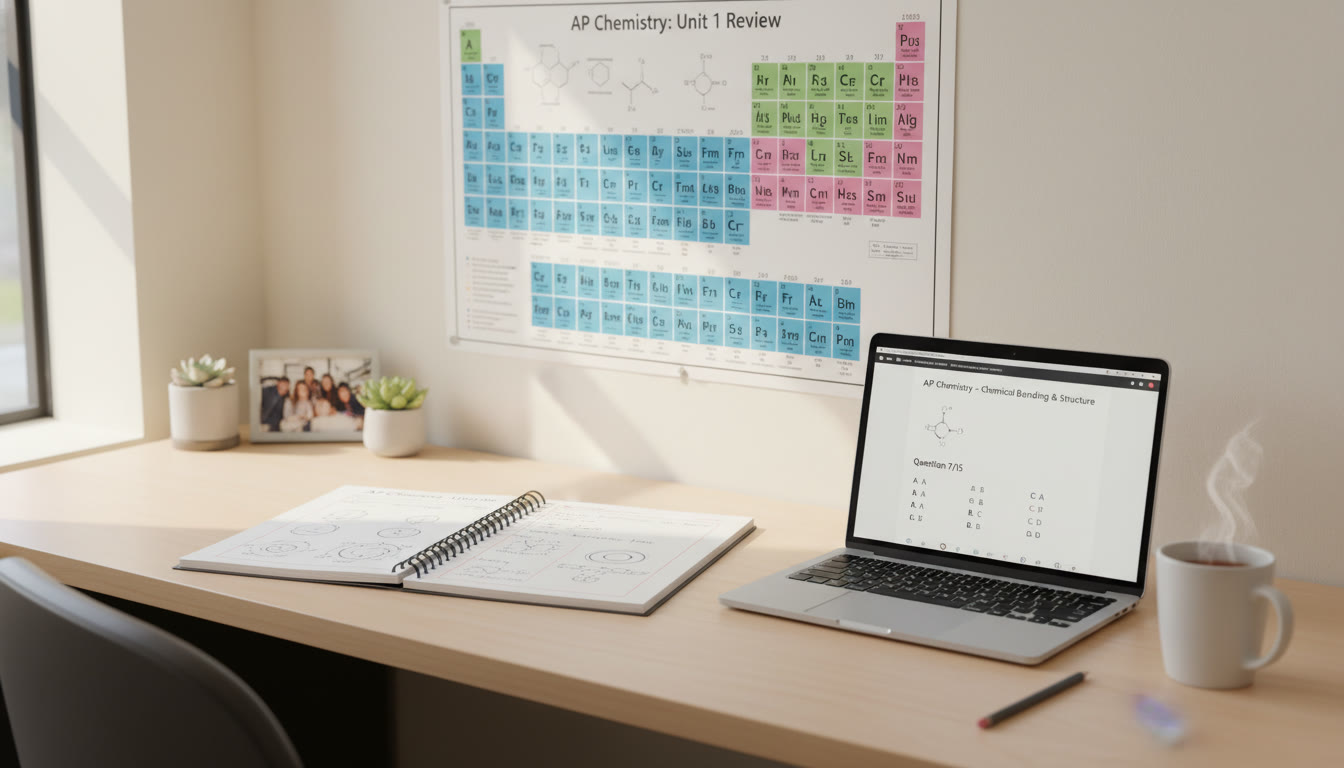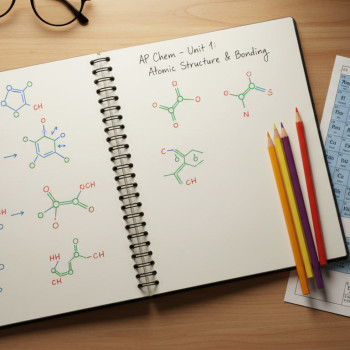Welcome — Why Unit 1 Matters More Than You Think
Think of Chemistry Unit 1 as the foundation of a house: if the foundation is solid, everything built on top — from reactions to equilibrium to electrochemistry — behaves predictably. On the AP Chemistry syllabus, Atomic Structure and Periodicity introduces the language of atoms, electrons, and trends across the periodic table. Master this unit and you’ll read formulas like a native speaker, solve problems with confidence, and see patterns rather than isolated facts.
What to Expect in This Guide
This post walks you through the core ideas of Unit 1, gives clear examples, offers comparison tables and study habits, and shares practical exam-ready tips. Along the way I’ll suggest high-leverage practice techniques and how Sparkl’s personalized tutoring can fit naturally into your prep — whether you need 1-on-1 guidance, tailored study plans, or AI-driven insights to identify weak spots.

Core Concepts — The Vocabulary You Need to Know
Before diving into problem solving, ensure you can define and use these terms naturally. They aren’t just words — they’re tools you’ll apply again and again.
- Atom — the smallest particle of an element that retains chemical identity.
- Proton, Neutron, Electron — subatomic particles. Protons are positive and define the element (atomic number). Neutrons add mass and influence isotopes. Electrons occupy energy levels and determine chemical behavior.
- Isotope — atoms with the same number of protons but different numbers of neutrons.
- Electron Configuration — the arrangement of electrons in shells and subshells (e.g., 1s2 2s2 2p6).
- Orbital — a region of space where an electron is likely to be found (s, p, d, f).
- Ionization Energy — energy required to remove an electron from an atom in the gas phase.
- Electronegativity — a relative measure of an atom’s ability to attract electrons in a bond.
- Atomic Radius — an estimate of the size of an atom; trends across the periodic table matter.
Quick Tip
Turn definitions into explanations you could give a friend in 20 seconds. Explaining aloud builds intuition: for example, say “Ionization energy goes up across a period because electrons are held tighter by more protons.” Short, accurate, and memorable.
Atomic Structure — Deeper Look with Examples
Atomic structure is where physical models meet problem-solving. You’ll move between conceptual ideas (what orbitals look like) and calculations (average atomic mass, electron configurations, and ion charge predictions).
Atomic Number, Mass Number, and Isotopes
The atomic number (Z) equals the number of protons. The mass number (A) equals protons + neutrons. Isotopes share Z but have different A. If a problem gives percent abundances and asks for average atomic mass, weight each isotope by its fractional abundance and add.
Example: Calculating Average Atomic Mass
Suppose Element X has 2 isotopes: X-35 (75%) and X-37 (25%). The average atomic mass is (35 × 0.75) + (37 × 0.25) = 35.5 amu. Practice these — they’re short calculations that show up often on exams and lab contexts.
Electron Configuration — Rules and Shortcuts
Electron configuration follows a few simple rules: Aufbau principle (fill lowest energy first), Pauli exclusion (max two electrons per orbital with opposite spins), and Hund’s rule (maximize unpaired electrons in degenerate orbitals). Learn the mnemonic for order (1s, 2s, 2p, 3s, 3p, 4s, 3d…) or visualize the diagonal rule to speed things up.
| Element | Atomic Number | Ground-State Configuration | Notes |
|---|---|---|---|
| Hydrogen (H) | 1 | 1s1 | One electron; simplest case |
| Carbon (C) | 6 | 1s2 2s2 2p2 | Valence electrons = 4 (2s and 2p) |
| Oxygen (O) | 8 | 1s2 2s2 2p4 | Tends to gain two electrons to fill 2p |
| Iron (Fe) | 26 | 1s2 2s2 2p6 3s2 3p6 4s2 3d6 | Transition metal: d-orbital behavior matters |
Practice Strategy
- Write configurations quickly for elements you see on practice tests.
- Use shorthand noble gas notation to save time (e.g., [Ne] 3s2 3p4).
- For ions, add or remove electrons after writing the neutral configuration.
Periodicity — Patterns That Make Chemistry Predictable
Periodicity is the beautiful part of the periodic table: trends emerge so you can predict behavior without memorizing each element. Focus on trends across a period (left → right) and down a group (top → bottom).
Key Periodic Trends
- Atomic Radius decreases across a period and increases down a group.
- Ionization Energy increases across a period and decreases down a group.
- Electronegativity roughly increases across a period and decreases down a group (excluding noble gases).
- Electron Affinity tends to become more negative across a period (with exceptions).
Why These Trends Happen
Across a period, protons are added to the nucleus without adding a new principal energy level, so the increased positive charge pulls electrons closer — smaller radius, higher ionization energy. Down a group, new energy levels are added, so valence electrons are farther from the nucleus and more shielded by inner electrons — larger radius, lower ionization energy.
Table: Periodic Trends Summary
| Trend | Across a Period (Left → Right) | Down a Group (Top → Bottom) |
|---|---|---|
| Atomic Radius | Decreases | Increases |
| Ionization Energy | Increases | Decreases |
| Electronegativity | Increases | Decreases |
| Metallic Character | Decreases | Increases |
Example Problem
Which has a larger atomic radius: Na or Cl? Both are in period 3. Na is left of Cl, so Na has a larger radius because it has fewer protons attracting the same principle energy level of electrons.
Applying Unit 1: Quick Problem Types & How to Tackle Them
Unit 1 problems come in a few predictable flavors. Recognizing the type helps you deploy the right method quickly during the AP exam.
Type 1: Calculation (Average Mass, Abundance)
Approach: convert percentages to decimals, multiply by isotopic masses, add. Check units — your answer should be in atomic mass units (amu) when dealing with isotopes.
Type 2: Electron Configuration and Ion Formation
Approach: write the neutral configuration, then add/remove electrons for ions. For transition metals, be careful—4s electrons often ionize before 3d in cation formation.
Type 3: Trend-Based Reasoning (Explain Why)
Approach: use core principles—nuclear charge, shielding, principal energy level. Always explain in terms of protons, electrons, distance from nucleus, and shielding by inner electrons.
Type 4: Conceptual (Orbital Shapes, Quantum Numbers)
Approach: link the quantum numbers to physical meaning: n = energy level, l = subshell shape (s=0, p=1, d=2), ml = orientation, ms = spin. Sketching simplified orbital diagrams can be faster than trying to remember words.
Smart Study Habits — Save Time, Score Higher
Studying smarter beats studying harder. Here are practical, evidence-based habits to help you learn Unit 1 efficiently.
Active Recall and Spaced Practice
- Flashcards that require you to produce electron configurations or justify a trend are better than passive re-reading.
- Spaced repetitions: revisit core facts several times over days to move them into long-term memory.
Practice With Purpose
- Do mixed-problem sets that combine isotope calculations, configurations, and trend explanations — this mimics the test environment.
- Check your answers by explaining them out loud or to a study partner. Teaching is a powerful test of understanding.
Simulate the Exam
Practice under timed conditions and grade yourself. The AP test requires not just knowledge but timing and strategy (when to skip a problem and return, how long to spend on multi-part questions).
How to Use Sparkl-Style Personalized Tutoring Effectively
If you’re considering extra help, personalized tutoring can accelerate progress by targeting your weak spots. Sparkl’s 1-on-1 guidance, tailored study plans, expert tutors, and AI-driven insights can be particularly helpful when:
- You repeatedly make the same mistake on electron configuration or periodic trend questions.
- You need a structured study calendar that fits extracurriculars and schoolwork.
- You want immediate feedback on practice problems and targeted mini-lessons for specific conceptual gaps.
Use tutoring sessions to work through difficult problems, practice verbal explanations, and get custom practice sets. The tutoring relationship should be collaborative: you bring effort and practice, the tutor brings clarity and strategies.
Common Pitfalls and How to Avoid Them
- Memorizing trends without reasoning — if you can’t explain why a trend occurs, you’ll be stuck on novel questions. Always ask “why?”
- Neglecting units — isotopic mass calculations expect amu; mixing units can cause silly mistakes.
- Overlooking exceptions — certain transition metal configs and electron affinity patterns have exceptions. Know the common ones and practice recognizing them.
- Ignoring practice timing — accuracy matters, but so does speed. Build both with timed sets.

Sample Study Plan (6 Weeks for Unit 1)
This plan assumes 4–6 hours per week devoted to Unit 1. Adjust based on your baseline and upcoming test dates.
- Week 1: Review atomic structure basics, subatomic particles, isotopes, and simple isotope calculations. Do 20 targeted practice questions.
- Week 2: Master electron configuration and orbital diagrams. Drill 30 configuration and ion questions. Time yourself.
- Week 3: Learn periodic trends deeply (atomic radius, ionization energy, electronegativity). Explain each trend in writing and solve 25 trend problems.
- Week 4: Mixed problem sets—include conceptual, calculation, and reasoning questions. Start timed sections.
- Week 5: Focused review on weak spots. Use personalized tutoring sessions to eliminate misunderstandings and create a mini-test tailored to your errors.
- Week 6: Full practice set simulating AP conditions. Review mistakes, write concise justifications for trend questions, and finalize quick-reference notes.
Why This Works
The plan mixes conceptual learning, practice, spaced review, and targeted intervention. If you use tutoring (e.g., Sparkl), allocate one session each week during Weeks 3–5 to refine explanations and check progress.
Exam Day Tips for Unit 1 Questions
- Read the prompt carefully; many questions hide a single key detail (like “in the gas phase” or “ground state”).
- Start with what you know: write the atomic number, then electrons, then configuration. Small scaffolding reduces mistakes.
- When asked to compare two elements, state the trend and the reason concisely: e.g., “Cl has higher electronegativity than S because Cl has greater effective nuclear charge across the period.”
- Use units and show work for calculations — partial credit matters.
Practice Problems — Try These Now
Working these will make Unit 1 feel routine. Time yourself and then compare the method you used with the one described here.
- Problem A: Calculate the average atomic mass for an element with isotopes at masses 28.0 (92.2%) and 29.0 (4.7%) and 30.0 (3.1%).
- Problem B: Write the ground-state electron configuration of Fe2+ and explain which electrons are removed first when forming Fe2+.
- Problem C: Explain why the first ionization energy of Be is greater than that of B, even though B is to the right of Be.
Hints
For Problem C, look at subshell structure: Be’s outer electrons occupy 2s whereas B starts filling 2p, and 2p electrons are easier to remove due to shielding and higher energy.
Final Words — Make Unit 1 Yours
Atomic Structure and Periodicity is less about memorizing a list and more about learning to think in patterns. When you can predict behavior, solve unfamiliar questions, and explain your reasoning, the exam becomes a test of communication more than recall. Keep practice short, focused, and regular. Use mixed-problem sets and timed practice to build speed. Consider occasional personalized tutoring sessions — they can transform months of unfocused study into high-impact learning with targeted feedback and tailored study plans, especially if you want expert tutors and AI-driven insights to track progress.
Above all, stay curious. When a trend surprises you, dig deeper. That curiosity is the engine of understanding, and it will serve you well not just on the AP exam but in any chemistry you do beyond it.























No Comments
Leave a comment Cancel